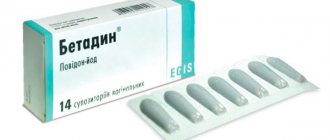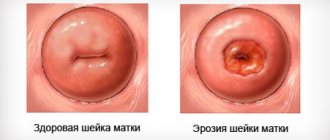Erosion is a pathological deformation of the mucous layer of the cervix, which provokes the development of many diseases of the female reproductive system and even infertility.
The greatest danger is the degeneration of erosion into a cancerous tumor, so it is quite important to promptly identify the disease and carry out appropriate therapy.
For cervical erosion, vaginal suppositories are often prescribed - as the main treatment or part of a complex treatment.
One of these drugs, Depantol, will be discussed later in the article.
Reasons for appearance
The exact mechanism by which the defect occurs is unclear. It is believed that various factors can cause erosion. It is noteworthy that each type of erosive spot is characterized by certain reasons for its development.
Gynecologists identify the following reasons that may contribute to the formation of erosion localized in the cervix.
- Congenital disorders. Sometimes the spot is found in girls and young women before the onset of puberty and intimate life. The occurrence of such a defect is associated with intrauterine disorders, as a result of which the normal differentiation of the epithelium is disrupted.
The vaginal part of the cervix is lined with cylindrical cells. This means that the transformation zone, which should not be visible, moves and can be visualized during inspection. After puberty is completed, as hormonal levels stabilize, the congenital spot regresses.
- The onset of sexual activity before the cervical epithelium has fully matured. Immature epithelium is susceptible to infections and external influences. Sexual intercourse before the age of 18 often leads to the development of true erosion and ectopia.
- Infections. Pathogenic microflora has a detrimental effect on the integumentary epithelium, causing true erosion and then ectopia.
- Cervical injuries. Difficult childbirth, abortion, curettage lead to cervical inversion or ectropion. Subsequently, an ulcerative defect forms on the injured cervix.
- Hormonal imbalance. It has been established that erosion often occurs as a result of changes in the level of sex hormones. In particular, a sharp decrease in estrogen affects the condition of the cervical epithelium, causing the formation of ulcers. This pathological condition is often diagnosed during pregnancy or menopause.
Depantol candles - description
Depantol vaginal suppositories are produced by Nizhpharm (Novgorod). These are odorless, yellowish suppositories, oblong, with a conical tip. In terms of its action, the drug for topical use belongs to the group of antiseptic and antimicrobial agents.
The composition is represented by two active components:
- Chlorhexidine. It is an antiseptic that is active against most types of bacteria.
- Dexpanthenol. It is a derivative of pantothenic acid (this is vitamin B).
As an auxiliary component, it should be noted the polyethylene oxide base, which provides the desired shape and weight of the candle. The medicine is widely used in gynecology, obstetrics - after childbirth, for the restoration of injured structures, the treatment of infectious diseases and for many other indications.
How do candles work?
The main effect of the drug is antiseptic. Chlorhexidine, which is part of the composition, inhibits the vital activity of various bacteria, protozoa - staphylococci, bacteroides, Escherichia coli, ureaplasma, streptococci, enterococci, neisseria and others. The drug has a negative effect on the development of chlamydia, therefore it is often prescribed in the complex therapy of chlamydia.
Only resistant strains, including hospital-acquired ones, respond poorly to treatment.
The effectiveness of candles is due to their combined composition. Due to the presence of vitamin B5, the medicine works as follows:
- improves tissue trophism;
- increases the rate of cell regeneration;
- participates in all types of metabolism;
- helps synthesize anti-inflammatory components;
- increases the strength of collagen fibers.
Depantol remains active even in the presence of pus, blood, and organic matter, while helping to protect wounds and cracks in the mucous membrane from infection. A distinctive feature is the lack of suppression of lactobacilli. After a course of use of suppositories, dysbacteriosis does not occur, which is why they compare favorably with other medications.
Depantol vaginal suppositories are produced by Nizhpharm (Novgorod). These are odorless, yellowish suppositories, oblong, with a conical tip. In terms of its action, the drug for topical use belongs to the group of antiseptic and antimicrobial agents.
- Chlorhexidine. It is an antiseptic that is active against most types of bacteria.
- Dexpanthenol. It is a derivative of pantothenic acid (this is vitamin B).
As an auxiliary component, it should be noted the polyethylene oxide base, which provides the desired shape and weight of the candle. The medicine is widely used in gynecology, obstetrics - after childbirth, for the restoration of injured structures, the treatment of infectious diseases and for many other indications.
How do candles work?
The main effect of the drug is antiseptic. Chlorhexidine, which is part of the composition, inhibits the vital activity of various bacteria, protozoa - staphylococci, bacteroides, Escherichia coli, ureaplasma, streptococci, enterococci, neisseria and others. The drug has a negative effect on the development of chlamydia, therefore it is often prescribed in the complex therapy of chlamydia.
Only resistant strains, including hospital-acquired ones, respond poorly to treatment.
The substance chlorhexidine (chlorhexidine digluconate) is active against the most common pathogens of female infections, which are found in 90% of women suffering from erosive tissue changes in the cervical area. These are bacteria, protozoa and viruses such as gardnerella, trichomonas, E. coli, Treponema pallidum, ureaplasma, chlamydia, streptococcus, staphylococcus, neisseria, herpes simplex virus.
The substance dexpanthenol in the patient’s body is transformed into pantothenic acid, which is a constituent component of coenzyme A. This process triggers a series of biochemical reactions, the result of which is the acceleration of tissue repair processes on the cervix (regeneration) and the normalization of metabolic processes in cells.
This combined drug is used in gynecology, has antimicrobial and antiseptic properties, improves tissue regeneration. It has several forms of release, including vaginal suppositories. The antiseptic effect is local, but, nevertheless, superficial self-medication is strictly contraindicated. Depantol suppositories have proven themselves well after cauterization of erosion, as an integral component of the rehabilitation period.
Compound
| active ingredients | Concentration mg in 1 suppository |
| dexpanthenol | 100 |
| chlorhexidine bigluconate | 16 |
| macrohead mixture | 2815 |
Release form
A typical medication has several forms of release, but in modern gynecology, suppositories for vaginal use and cream have proven themselves especially well. After the introduction of suppositories, stable positive dynamics of the underlying disease is ensured, however, such conservative treatment in practice can provoke an allergic reaction. In any case, one cardboard package contains 5 candles on a blister, and instructions for use are included.
This antiseptic substance in its chemical composition disinfects microflora and restores the mucous membranes of the vagina. In addition, the drug in the form of suppositories accelerates healing after pathological childbirth and destroys many forms of pathogenic bacteria. Depantol is recommended for use by patients with the following clinical conditions:
- vaginitis of acute and chronic form;
- true cervical erosion;
- rehabilitation after destructive methods of treatment;
- exo- and endocervicitis;
- postoperative period for accelerated healing of sutures;
- cystitis;
- thrush.
If we say a few words about the cream of the same name, it is used externally for cracked nipples of the mammary glands, ruptures, and as a local antiseptic. The chemical composition of both medications is identical, however, vaginal suppositories act much faster on the site of pathology, while providing significant changes for the better in the shortest possible time of conservative treatment at home. In gynecology, doctors often choose Depantol suppositories rather than cream.
Depantol suppositories are intended as an effective medicine for vaginal diseases and are used intravaginally. Possessing antimicrobial activity, positive dynamics are observed at the very beginning of the course of treatment, but the prescribed therapy is indicated to be completed to the end. The use of this antiseptic is indicated for 7 to 10 days, but if necessary, this time interval is increased to 20 days. To treat erosion, it is necessary to insert a suppository deep into the vagina in the morning and evening.
A similar pharmacological prescription for thrush, and discharge after Depantol suppositories will stop within 2-3 days. The pathogenic fungus reduces its harmful activity, so the unpleasant odor from the vagina, burning and severe itching disappear. Abnormal discharge becomes scarce and soon stops appearing altogether.
A typical medication promotes tissue regeneration, but its effect in the body is selective. Not all patients are suitable for this pharmacological prescription, as evidenced by reviews on the World Wide Web. If this cheap drug is ineffective or causes side effects in the form of vaginal discharge, it is better to replace it with an analogue. The following treatments are especially effective in a given direction:
- Betadine;
- Citeal;
- That's right Keith;
- Hexicon;
- Gynoflor;
- Kolposeptin;
- Chlorhexidine;
- Osarbon;
- Furazolidone;
- Eucolec;
- Povidin;
- Ecovag;
- McMiror;
- Klioron;
- Betadine.
| Name of pharmacy in Moscow | Price, rubles |
| ZdravZone | 470 |
| Pharmacy IFC | 625 |
| EuroPharm | 600 |
| ElixirPharm | 630 |
| Samson Farm | 570 |
| Kremlin pharmacy | 560 |
| Pharmacy Dialogue | 650 |
Use for thrush
Whether Depantol treats thrush depends on the type and nature of the disease. The drug exhibits the greatest therapeutic effect for mixed bacterial and fungal infections as part of complex therapy. Depanthol relieves inflammation and swelling, restoring damaged tissue. For targeted treatment of candidiasis, it is better to use drugs that have a proven antifungal effect.
In addition, after successful completion, you need to consolidate the result - normalize the vaginal microflora and monitor the immune system. It is recommended to reduce the proportion of sweets and baked goods in the diet.
Regarding the use of Depantol suppositories for thrush, reviews from patients are mixed. Many women experience intolerance to the drug. Even in the same patient, its use at different times can cause different reactions.
Depantol helps very well in healing wounds after treating cervical erosions for thrush. But if it is impossible to tolerate the burning sensation when using suppositories, then it is better to consult a gynecologist so that he can prescribe a more suitable medication.
Depantol suppositories are one of the few products intended for the treatment of thrush and other vaginal infections that are approved for use during pregnancy. The components of the drug do not have a systemic effect on the body, showing only a local effect, and therefore will not cause any harm to a pregnant woman and the child she is carrying.
You can buy Depantol suppositories in many pharmacies throughout Russia. To choose the most suitable option for the price, you can call the pharmacy help desk in advance or explore the selection on the Internet.
The average price for Depantol candles is 600 rubles. The price range for this drug in retail pharmacies, especially in large cities, can reach 100 rubles or more. The cost of Depantol varies from 500 to 700 rubles.
Online pharmacies are convenient because many medications are cheaper to order through them. Delivery can be arranged to a pharmacy located near your home. The website shows promotions and discounts that are currently in effect. For the purchase of many medications, additional bonuses are awarded that can be used in further payments.
Various release forms
The danger of erosion is that it is asymptomatic. This means that in order to identify a defect in the integumentary epithelium, you need to consult a doctor and undergo an examination. Often, experts define ectopia, which means the presence of an area formed by cylindrical cells of the cervical canal.
The only symptom of pseudo-erosion is mucous discharge, which appears as a result of the functioning of the glands of single-layer epithelium at the site of erosion. During sexual intercourse or examination by a gynecologist, spotting may occur due to trauma to the spot, which is susceptible to external influences.
Signs of erosion are detected by visual examination of the cervix and assessment of the condition of its mucosa.
- True erosion looks like a wound that can bleed upon contact with the doctor's instrument. With true erosion, an inflammatory process often occurs.
- Congenital erosion looks like a reddish spot, which differs from the healthy pale pink mucosa. There are usually no signs of infection.
- Ectopia is manifested by the formation of a spot, which can have different shapes and sizes. A characteristic symptom of pseudo-erosion is the presence of an inflammatory process.
To treat cervical erosion, the only form of release of Depantol is used - vaginal suppositories. Each suppository contains 0.016 g (16 mg) of chlorhexidine and 0.1 g (100 mg) of dexpanthenol. The package contains 5 and 10 suppositories.
The drug is also available in two more forms, used for other pathologies:
- Cream for external use;
- Spray for external use.
During pregnancy
During pregnancy and lactation, doctors do not exclude such pharmacological prescription at home. The use of Depantol suppositories is appropriate for thrush that progresses against a background of weakened immunity for productive healing of the mucous membranes. The healing processes are not accompanied by a deterioration in general health; the active components of the suppositories are not excreted in breast milk and do not cross the placental barrier. Therefore, restrictions on use do not apply to these categories of patients.
Who is the drug indicated for?
Indications for use are varied. Vaginal suppositories dissolve quickly, so the therapeutic effect is achieved within a few minutes. In gynecology, medicine is prescribed for the following problems:
- Acute vaginitis is inflammation of the vagina caused by nonspecific flora, as well as chronic vaginitis. In complex therapy – for a specific type of infection.
- Cervicitis, exocervicitis - inflammation of the cervix in the vaginal part and cervical canal.
- Endocervicosis is a displacement of the cervical epithelium.
- Various types of cervical erosion, especially complicated by bleeding and inflammation.
- Thrush in recurrent form.
It is often recommended to light candles for women in labor. Indications for use in obstetrics are sanitation of the birth canal before natural delivery. This need arises in the presence of bacterial vaginosis, vaginitis, cervicitis and other infectious pathologies. After a traumatic birth, it is also recommended to undergo a course of Depantol therapy.
Depantol will be a preventative against infections when installing or removing the spiral. Without compromising local immunity, it will prevent the unpleasant consequences of intrauterine contraception.
- Acute vaginitis is inflammation of the vagina caused by nonspecific flora, as well as chronic vaginitis. In complex therapy - for a specific type of infection.
- Cervicitis, exocervicitis - inflammation of the cervix in the vaginal part and cervical canal.
- Endocervicosis is a displacement of the cervical epithelium.
- Various types of cervical erosion, especially complicated by bleeding and inflammation.
- Thrush in recurrent form.
It is often recommended to light candles for women in labor. Indications for use in obstetrics are sanitation of the birth canal before natural delivery. This need arises in the presence of bacterial vaginosis, vaginitis, cervicitis and other infectious pathologies. After a traumatic birth, it is also recommended to undergo a course of Depantol therapy.
Analogs
Analogues of Depantol suppositories are numerous and varied. Many of them have a lower cost compared to the drug in question. The most popular drugs are:
The above drugs are intended to combat bacterial inflammatory infections of the female genital organs. All of them are produced by Russian manufacturers.
There are many foreign analogues of Depantol on sale with different compositions. For example, Betadine (Hungary), Povidone-Iodine (Serbia), Vokadin (India) are made on the basis of povidone-iodine. The products are intended for the treatment of acute and chronic vaginitis, trichomoniasis, and as a prophylactic against infections during gynecological operations. To persons with problems with the thyroid gland, these drugs should be prescribed with caution, as they may lead to the development of hyperthyroidism.
All of the above suppositories have an antifungal effect. But when healing cervical erosions, other medications are used (Vagotil, Genferon, Solkovagin, Hypozol, etc.). Thus, Depantol has no absolute analogues.
Diagnostics
Timely detection of the disease prevents the occurrence of serious pathologies. Since erosion does not have severe symptoms, gynecologists pay attention to the importance of preventive examinations. Regular examination allows you to detect a cervical defect in a timely manner and begin the necessary treatment on time.
The main treatment involves cauterization using various methods. Identifying an erosive spot at an early stage allows the use of suppositories that have anti-inflammatory and regenerating effects as therapy.
The doctor makes a diagnosis during examination and evaluation of the cervical mucosa in the speculum. In addition, the appearance of the defect can differentiate its type. However, one examination by a gynecologist is not enough. It is known that dangerous diseases, including cancer, can be hidden under erosion.
In order to exclude precancerous processes and cancer, and identify concomitant gynecological diseases, you need to undergo an examination:
- flora smear;
- cytological examination;
- bacterial sowing;
- PCR diagnostics of sexually transmitted infections;
- colposcopy;
- biopsy.
The main diagnostic methods are visual examination and colposcopy. The two studies are similar. The difference is that during a colposcopy, the doctor examines the cervix through a colposcope. This device consists of a magnifying and lighting system that allows you to examine the mucous membrane in detail.
In order to accurately determine the affected area, the doctor performs an extended version of colposcopy, during which the cervix is treated with special solutions. An uncolored area may indicate the development of dysplasia.
In order to exclude dysplasia and cervical cancer, the gynecologist performs a biopsy. He takes a piece of the affected tissue for examination under a microscope, which will be carried out in the laboratory.
Careful diagnosis is essential when prescribing treatment. For example, cauterization using diathermocoagulation or another method is contraindicated in the presence of a malignant tumor. The use of candles in this case is also not justified.
Who should not use the drug?
The only serious prohibition on use is intolerance to the components. Since chlorhexidine and dexpanthenol in this form are practically not absorbed into the bloodstream, the risk of developing allergies is minimal. There is no experience in using the medicine in children, so it is indicated only for adults over 18 years of age.
During pregnancy and lactation, the medicine is not contraindicated. It is especially often recommended for thrush, vaginosis, and colpitis. Suppositories help to disinfect the mucous membrane and heal it without harm to the child. Side effects from the introduction of suppositories are common, but pass quickly.
- burning, itching;
- hyperemia of the external genitalia;
- rarely - rash, local allergy phenomena.
Very rarely, women report bleeding from the vagina and increased yellow discharge. Anyone who experiences such sensations should consult a doctor. During treatment, you should not use soap or surfactants for washing - this increases the risk of developing side effects.
- burning, itching;
- hyperemia of the external genitalia;
- rarely - rash, local allergy phenomena.
Very rarely, women report bleeding from the vagina and increased yellow discharge. Anyone who experiences such sensations should consult a doctor. During treatment, you should not use soap or surfactants for washing - this increases the risk of developing side effects.
Bepanten is the main analogue
The drug is based on dexpanthenol and chlorhexidine. The medicine is applied to the affected areas, as it comes in the form of an ointment. The main purposes of Bepanten are antibacterial, anti-inflammatory and healing. It is recommended to use it for inflammation and infections of the dermatological surface. The ointment has a shelf life of up to three years, which means that after purchasing it once, you can not be afraid of skin infections for a couple of years, because you will have a decent weapon in your arsenal. The composition of the drug is so safe that it can even be used on a newborn baby.
Among the disadvantages, consumers note the high price of the ointment. From two hundred rubles to a thousand.
Side effects may include itching and burning in the area of application, and the possibility of an anaphylactic reaction cannot be ruled out.
In this video you will learn why thrush appears and how to treat it:
In modern gynecology, for skin infections and soft tissue ruptures, doctors prescribe the local antiseptic Depantol suppositories. This medication has antimicrobial properties, productively regenerates injured structures, and acts locally on the site of pathology. Very often, Depantol suppositories are prescribed after childbirth, especially if there were perineal ruptures with a large fetus. However, this is not the only medical indication when such pharmacological prescription is appropriate.
Using candles
Therapeutic tactics depend on the type of erosive formation. The congenital form regresses on its own; treatment with suppositories is required only when an infection occurs. True erosion is diagnosed extremely rarely due to the too short period of progression. Therapy in this case is aimed at eliminating the cause of the defect and stimulating the healing process, which can be accomplished by taking various suppositories, for example, Depantol.
Cauterization is performed when ectopia is detected. Before cauterization is carried out, it is necessary to eliminate the infection and inflammation. Cauterization is carried out using several techniques, one of which is diathermocoagulation. After the patient has cauterized the erosion, gynecologists sometimes recommend taking suppositories, for example, Depantol.
Suppositories after cauterization of cervical erosion promote healing of epithelial tissue, dissolution of a scab or crust, and prevent infection. However, not every moxibustion tactic requires the use of suppositories. After a woman has cauterized the defect using diathermocoagulation, it is advisable to use suppositories, in particular Depantol.
Ectopia can be eliminated using the following methods of cauterization and a course of suppositories.
- Diathermocoagulation. One of the most effective methods of cauterization, called diathermocoagulation, has many negative sides. The erosion can be cauterized with electric current or diathermocoagulation, after which a crust is formed on the surface of the cervix, called a scab. The disappearance of the scab is observed on the tenth to fourteenth day. Tissue restoration after cauterization by electric current or diathermocoagulation occurs within two months. During the healing period, bloody and bloody discharge is possible.
During the recovery period after diathermocoagulation, a woman is recommended to use suppositories that have an anti-inflammatory and healing effect. Suppositories that promote tissue regeneration are used after normalization of discharge. Quite often, gynecologists recommend Depantol suppositories after a woman has cauterized the erosion with diathermocoagulation.
Depantol has several dosage forms. In particular, many women use Depantol in the form of a gel, suppositories, ointment or aerosol. Depantol has good absorption and high efficiency.
- Radio wave cauterization. After the patient has cauterized the erosion with radio waves, complications usually do not occur, unlike diathermocoagulation. Radio wave cauterization is considered the most gentle method of eliminating erosion, which does not require the use of anti-inflammatory suppositories. Depantol suppositories can be used as prophylaxis.
- Cryodestruction. Only minor erosion can be cauterized with liquid nitrogen. After the scab has passed, it is possible to use regenerating suppositories, for example, Depantol or Methyluracil.
- Laser vaporization. The cauterization method is based on the use of a laser beam that evaporates erosive cells. When the patient has cauterized the defect using laser vaporization, after a few days you can use Depanthol or other healing suppositories.
Mode of application
Depantol suppositories have only one method of use, this is vaginal administration. As soon as the candle is removed from the sealed package, it must be inserted immediately. The most common dosage schedule is one suppository twice a day. The general course of treatment rarely exceeds ten days, but for acute diseases the doctor can extend the duration of treatment to twenty days.
During pregnancy or in the first days after childbirth, a treatment regimen is created individually by a specialist. It is not uncommon that in the first month after the birth of a baby, suppositories are prescribed along with antibiotics, or they are completely replaced with tablets. In general, the treatment regimen rarely changes both during pregnancy and after, regardless of whether the child is breastfeeding or not.
How to use and what to replace candles with?
For suppositories to help, you must strictly follow the doctor's instructions regarding the course and frequency of use. The suppositories should be inserted into the vagina as far as possible in a lying position, legs bent, knees spread apart. After administration, you need to lie down for 15 minutes. How many days to use the drug? Usually prescribed as a suppository in the morning and evening for 7-10 days. In chronic forms of pathologies, after operations, the course is often extended to 20 days.
Treatment should be started outside of menstruation.
There are few analogues of Depantol, there are cheaper products. The composition is similar to Pantoderm cream, but it is used mainly in dermatology. Candles with similar effects are shown in the table.
| Name | Compound | price, rub. |
| Betadine | Povidone-iodine | 520 |
| Panthenol | Dexpanthenol | 300 |
| McMirror | Nifuratel, nystatin | 850 |
| Hexicon | Chlorhexidine | 315 |
| Chlorhexidine | Chlorhexidine | 150 |
The price of Depanthol candles is about 560 rubles/10 pcs. Their effectiveness is high, their composition is unique, so it is not recommended to replace them with other suppositories yourself.
netbolezni.net
Reviews
Women who have tried Depantol on themselves agree on its effectiveness.
Irina, 28 years old, Birobidzhan: “These suppositories helped me heal erosion. The gynecologist prescribed radio wave treatment, and then Depantol, so to speak, to consolidate the effect. In my opinion, this remedy can only be used in combination with the main method of treatment, as it is written in the instructions. But suppositories themselves will not cure anything.”
Alena, 41 years old, Moscow: “I used Depantol suppositories against thrush several times. Although they write that it is not intended for this, it helped me. Another plus is safety, because it is prescribed even during pregnancy, which means it definitely won’t do any harm. I recommend!".
Natalia, 45 years old, Cheboksary: “After the biopsy, the gynecologist prescribed me Depantol suppositories. 4 days after the start of the course, I started bleeding a little. But the doctor said that this could be the case and that treatment should be continued. I hope everything works out. What does anyone think about this, very interesting?”
Depantol candles - description
How do candles work?
The cauterization method for treating erosion is prescribed individually for each woman. Its use depends on the condition of the cervix, the results of tests and examination by a gynecologist.
Cauterization is carried out using chemicals (solkovagin) or physical methods:
- Diathermoelectrocoagulation (electric shock) is a common and outdated method of treatment. Widely used several years ago.
- laser cauterization (laser coagulation),
- cauterization with nitrogen (cryodestruction),
- cauterization using radio waves (radio wave coagulation).
Scar tissue forms at the site of exposure by any means. Underneath it, cell regeneration occurs. During this period, healing suppositories are prescribed after cauterization of cervical erosion.
Suppositories have positive effects after the procedure:
- promote rapid healing,
- prevent the development of infections without disturbing the balance of vaginal microflora,
- eliminate pain due to the softening effect,
- reduce the inflammatory process.
The attending physician decides which suppositories to prescribe after cauterization of cervical erosion. The following matters when choosing a drug:
- the method of treatment used (cryodestruction does not require additional treatment measures, and after diathermoelectrocoagulation the use of healing drugs is necessary),
- condition of the cervix after the procedure,
- the woman has infectious diseases, vaginal dysbiosis,
- state of the body's protective functions (immunity),
- features of the regenerative function of the body, speed of wound healing.
Depending on these factors, suppositories with anti-inflammatory, healing or antibacterial effects are used.
Cauterization of erosion with electric current leads to the formation of a scab in its place, which disappears in two weeks. During tissue restoration, bloody, purulent discharge may be observed. Afterwards, a rough scar forms on the mucous membrane, which can lead to problems with conception, complications during pregnancy and difficult childbirth.
Anti-inflammatory suppositories are prescribed before cauterization. Using them a week before the procedure can reduce the risk of developing infectious diseases and reduce the inflammatory process. These include:
- Hexicon has an antiseptic, anti-inflammatory effect,
- Polizhinaks, Terzhinan are combination drugs that have antimicrobial and antifungal effects.
- Livarol, Zalain, Pimafucin - antifungal drugs,
- Syntomycin suppositories have an antibacterial effect.
Healing suppositories after cauterization of cervical erosion are used when a woman stops spotting (five days after diathermoelectrocoagulation). Before using suppositories, it is necessary to douche with furatsilin solution. Prescribed:
- Depantol suppositories have a regenerating, antimicrobial effect. Apply twice a day for a week.
- Methyluracil suppositories have a healing, anti-inflammatory effect and can restore immunity. Improves metabolic processes and nutrition in cells. Methyluracil suppositories are rectal, but can be prescribed by gynecologists for vaginal use. Single dose 1-2 suppositories up to 4 times a day. The duration of treatment is determined by the doctor, but not more than 4 months.
- Suppositories with sea buckthorn oil. They have a healing effect, relieve pain, inhibit pathogenic microorganisms, relieve swelling and inflammation after cauterization. Treatment is carried out for 14 days, one dose 2 times a day.
Treatment of erosion with radio waves is a modern method that differs:
- high level of efficiency,
- absence of painful sensations,
- rapid tissue restoration without scar formation, therefore suitable for nulliparous women,
- antibacterial effect,
- the only drawback is the high cost.
The procedure lasts 15 minutes and is painless. After cauterization of cervical erosion with radio waves, the use of local drugs is not required, or the doctor may prescribe Depantol suppositories. It takes a month for the mucous tissue to fully recover after using radio waves.
The use of liquid nitrogen in the treatment of erosion is based on its ability to freeze tissue, forming crusts that subsequently die. The procedure does not cause pain, and after coagulation there is no scar left (can be used by nulliparous women).
After two weeks, healthy tissue forms at the site of nitrogen exposure, and the scab is rejected. After this, the drugs Depantol or Methyluracil are used for healing. It takes one and a half months for the mucous membrane to fully recover; during this period, slight spotting is possible.
Laser vaporization is a safe and highly effective treatment method; relapses of erosion occur extremely rarely. The method allows you to accurately influence the foci of erosion under the control of a video colposcope, and is carried out without the use of painkillers.
To speed up tissue healing after cauterization, any suppositories with a regenerating effect (Depantol, etc.) are prescribed.
The chemical coagulation method involves applying active drugs to the damaged areas of the cervical mucosa. The procedure is carried out using a colposcope, which ensures precision processing. Solkovagin and Vagotil are used for cauterization. The active ingredients of the drugs destroy the top layer of cells, in place of which a healthy layer of mucous begins to form.
The negative aspects of the method include the duration of exposure to drugs before the onset of effect, the formation of scars, low efficiency and a high percentage of relapses.
The use of healing and anti-inflammatory suppositories after chemical coagulation is mandatory, but as prescribed by a doctor.
The modern method of argon coagulation involves treating erosion with argon plasma. The treated area heats up and dies.
Treatment with argon is painless, does not leave scars on the mucous tissue, and is recommended for nulliparous women.
Complete recovery occurs in a short time; during this period, suppositories with a healing effect (Depantol, Methyluracil) are prescribed.
Cervical erosion or ectopia is a pathology of the integrity of the membrane of the vaginal part of the cervix, which is expressed in defects or ulcerations on the mucosa. Erosion often becomes the initial stage of cancerous changes in the epithelial layer of the cervix, and the presence of HPV in a woman significantly increases the risk of developing a malignant tumor.
Cervical erosion is a red area ranging in size from a few millimeters to 1.5-2 centimeters, located along the edges of the external os of the cervix, which extends into the vagina. The pathology is practically painless and asymptomatic.
The appearance of pathology is influenced by many both external and internal factors, but the main ones are often the following:
- failure to comply with the rules of personal and intimate hygiene;
- frequent change of sexual partners;
- mechanical injury to the mucous membrane, which often occurs during certain medical procedures, during abortion and difficult childbirth, sometimes when using certain vaginal contraceptives and self-douching, as well as during too rough sexual contacts;
- hormonal disorders;
- some infectious or inflammatory diseases of the genitourinary system and, as a result, decreased immunity.
Early sexual life, pregnancy and childbirth at a fairly young age can also trigger the appearance of cervical erosion.
However, sometimes erosion manifests itself as bloody discharge in the middle of the menstrual cycle, especially often after sexual intercourse, pain during sex or vaginal discharge.
There are several types of pathology:
- congenital - expressed in redness and outward displacement of the boundaries of the epithelium lining the cervical canal. This pathology appears in girls during the period of intrauterine development and in most cases heals on its own. But there is a possibility of infection of such erosion, which provokes the appearance of foci of inflammation. It is this form of pathology that never degenerates into a malignant tumor;
- pseudo-erosion is a small (about 5 mm) red area, sometimes located outside the cervical canal. This pathology is typical for patients with elevated hormonal levels, and its danger lies in a fairly high risk of degeneration into a cancerous tumor. Sometimes such erosion can fester, which indicates that the process of its development is neglected;
- true - the most common form of pathology, which appears on the cervix in the form of a bright red spot that bleeds when pressed. It often becomes inflamed and festeres. True erosion in a woman lasts only a few weeks, and then develops into pseudo-erosion due to the proliferation of connective tissue.
After diagnosing the pathology and determining the type of erosion, the gynecologist determines the method of treatment.
In the case of congenital and pseudo-erosion, therapy can be avoided and minimal procedures can be used to eradicate it. True cervical erosion requires conservative treatment and sometimes surgical intervention.
Conservative treatment is aimed at eliminating the root cause of the pathology, and is also used in the presence of concomitant infectious and inflammatory processes.
How do candles work?
Side effects
Side effects of Depantol occur quite rarely, with increased sensitivity of the patient to its components:
- Dryness of the vaginal mucosa;
- Itching of the vagina and external genitalia (perineal area);
- Burning during urination and sexual intercourse;
- Redness of the vaginal cavity, perineal skin;
As a rule, all symptoms of side effects disappear without additional intervention after stopping the medication. There have been no reports of possible overdose with this drug.










